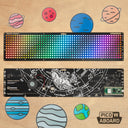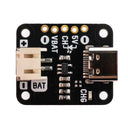Pico 2 W Unicorn
by Pimoroni







Gorgeous programmable LED matrix displays with wireless connectivity and oodles of fancy extras! 🦄
Our space Unicorns are very beautiful, all-in-one, RP2350 powered LED matrices perfect for conveying information fabulously (or for sprucing up your desktop, makingspace or imaginarium). There's a ton of features aboard, here are some of our favourites!
🌈 Loads* of RGB LEDs, all with individual colour and brightness control. We're in mad love with these big bright squircular LEDs with their rounded apertures and built in diffusion.
📷 Looks great on video - invoking RP2350 magic means we can update the LEDs really quickly (we measured around 300 fps at 14-bit precision). This means there's no nasty strobing, artifacting or brightness stepping when it's filmed, so it's perfect for adding to the background of your streaming setup.
🌍 2.4GHz wireless connectivity (courtesy of the Raspberry Pi Pico 2 W) so you can use it to display all sorts of interesting data from the internet.
There's also an onboard amp and little speaker for bleepy alerts and *futuristic noises* and a battery connector so you can power it without it having to be tethered to a USB port. Every Unicorn comes with a pair of sleek little metal legs so it can stand up on its own (and has a selection of mounting holes if you'd prefer to do something else).
Use it to make a very fancy clock, a very fancy weather display or a very fancy output for sensors (other very fancy use cases are available).
What's new? 😎
As of mid-December 2024, Pico Unicorns are now Pico 2 W Aboard! Pico 2 W and it's souped-up RP2350 chip bring some exciting improvements - including a higher core clock speed, double the on-chip SRAM and double the on-board flash memory. RP2350 adds hardware support for floating point number crunching, which means graphical effects and demos should run even faster!
Which Unicorn to choose?
All varieties of Unicorn have the same great core features: buttons, a speaker, a battery connector and an onboard Pico 2 W. However, there's now three different shapes and sizes, with varying amounts of LEDs. Here's a little comparison chart to make sure you get just the right amount (like mecha-Goldilocks 🤖).
| Unicorn | *How many LEDs |
Arranged in a... |
Size of board (L x W x D) |
| Stellar | 256 | 16 x 16 square grid | 108 x 108 x 10.2 mm |
| Galactic | 583 | 53 x 11 wide grid | 330 x 78 x 10.2 mm |
| Cosmic | 1024 | 32 x 32 square grid | 204 x 204 x 10.2 mm |
Features
- Raspberry Pi Pico 2 W Aboard
- Dual Arm Cortex M33 running at up to 150MHz with 520KB of SRAM
- 4MB of QSPI flash supporting XiP
- Powered and programmable by USB micro-B
- 2.4GHz wireless
- 256/583/1024 RGB LEDs in a 16x16/53x11/32x32 grid
- 3.5mm LEDs with rounded square apertures
- 6mm LED spacing
- Driven by FM6047 constant current LED drivers
- MAX98357 3.2W I2S Mono Amplifier (with 30mm 1W speaker)
- Phototransistor for light sensing
- 9 tactile user buttons
- Reset button
- 2x Qw/ST (Qwiic/STEMMA QT) connectors
- JST-PH connector for attaching a battery (5.5V max)
- Fully assembled
- No soldering required.
- Programmable with C/C++ or MicroPython
- Schematics - Stellar / Galactic / Cosmic
Kit includes
- Stellar/Galactic/Cosmic Unicorn (with speaker attached)
- 2 x metal legs
- USB A to micro-B cable
Getting Started
To make it easy to get started, all our Unicorns ship pre-loaded with pirate brand MicroPython and a demo reel of pretty examples to stare at.
You can find more examples on Github:
Not your everyday RGB LEDs
In our software, we use the Pico 2 W's PIOs (Programmable IOs) to drive the LEDs. Internally, Unicorn applies gamma correction to the supplied image data and updates the display with 14-bit precision resulting in extremely linear visual output - including at the low end.
The display is refreshed around 300 times per second (300fps!) allowing for rock solid stability even when being filmed, no smearing or flickering even when in motion.
Connecting Breakouts
The Qw/ST connectors make it super easy to connect up Qwiic or STEMMA QT breakouts. If your breakout has a QW/ST connector on board, you can plug it straight in with a JST-SH to JST-SH cable.
Breakout Garden breakouts that don't have a Qw/ST connector can be connected using a JST-SH to JST-SH cable plus a Qw/ST to Breakout Garden adaptor. Want to use >2 breakouts at the same time? Try this adaptor!
- List of breakouts currently compatible with our C++/MicroPython build.
Notes
- Power consumption stats! ⚡ We measured Galactic and Cosmic Unicorn as consuming just over 1A at maximum brightness, full white. When choosing a battery, consider that the LEDs will look their absolute best when they have access to at least 3.6V of power. At lower voltage levels you will start to see the blue elements of the LEDs fading out - this starts to become very noticeable at 2.9V and below. For best results when running on battery, we'd suggest using a chunky LiPo (check out the extras for some suggestions).
- Note that Unicorns have no battery charging hardware onboard - this is so you can use either alkaline or LiPo batteries safely. You'll need to charge up your LiPo battery with a separate battery charger (we like LiPo Amigo).
- Squircle alert! 🟪🔵 Some batches of Unicorns have LEDs with more rounded apertures (though the LED specs and brightness remain the same). They all look good, but if you want a perfectly visually matched pair (or stable) of Unicorns it's probably best to buy them at the same time.
Printables
Want to cut a diffuser or 3D print a case? Check these out:
Stellar
- Stellar's 4 mounting holes are M2 and 3mm in from the edge. The leg holes are M2.5.
- .dxf files for the board outline:
Galactic
- Galactic's 8 mounting holes are M2, 3mm in from the edge, and equally spaced 108mm horizontally and 72mm vertically. The leg holes are M2.5 (we've added two sets so you can adjust the angle).
- .dxf files for the board outline:
- Screen mount with pivot stand
- Templates for box joint case and diffuser grill
Cosmic
- Cosmic's 7 mounting holes are M2, 3mm in from the edge, and equally spaced 99mm horizontally and vertically. The leg holes are M2.5 (we've added two sets so you can adjust the angle).
- Dimensional drawing
- .dxf files for the board outline:
Don't have easy access to a laser cutter? We also sell diffusers here.
About RP2350
The RP2350 chip is the Double Quarter Pounder & Fries to the RP2040's Double Cheeseburger and can have one or more RISC-V burgers instead of either of the M33 ARMs, to stretch the metaphor.
In addition to the modern M33 ARM cores, there are sides of: more PIO capability, a variety of low power states for sipping electrons, a whole security system and some sprinklings of specialist digital video circuits to offload DVI/HDMI output.
You can expect a tasty boost in performance - our "real world" MicroPython tests are running up to 2x faster compared to RP2040, and floating point number crunching in C/C++ is up to 20x faster. The extra on-chip RAM will make a big difference when performing memory intensive operations (such as working with higher resolution displays) and even more can be added thanks to external PSRAM support.
RP2350 comes in two flavours - A (standard) and B (all the pins). The B chip has a stonking 48 usable GPIO pins, including 8 ADCs and 24 PWMs, and features on some of our new products.
-
Stellar (16x16)
PIM73630% off!£22.75was £32.50 -
Galactic (53x11)
PIM734Out of stock£48.75 -
Cosmic (32x32)
PIM73530% off!£46.40was £66.25
LiPo battery
A rechargeable LiPo pack and our LiPo Amigo charger
-
Lithium Ion Battery Pack+ £4.95
-
 LiPo Amigo (LiPo/LiIon Battery Charger)+ £3.25
LiPo Amigo (LiPo/LiIon Battery Charger)+ £3.25
Add an acrylic diffuser layer
Shield your eyes from your Space Unicorn's dazzling rays (whilst adding some lovely bokeh)!
-
 Unicorn Diffuser Kit+ £2.45
Unicorn Diffuser Kit+ £2.45
Shop with confidence – we've been serving the hobbyist electronics, Maker, and retro gaming communities since 2012.
- Satisfaction or refund guarantee
- Worldwide shipping via mail or courier
- 57,000+ customer reviews
- Secure website and payments




